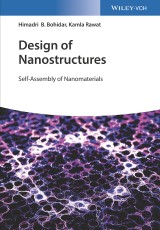Details
Design of Nanostructures
Self-Assembly of Nanomaterials1. Aufl.
|
138,99 € |
|
| Verlag: | Wiley-VCH |
| Format: | EPUB |
| Veröffentl.: | 22.06.2017 |
| ISBN/EAN: | 9783527810437 |
| Sprache: | englisch |
| Anzahl Seiten: | 352 |
DRM-geschütztes eBook, Sie benötigen z.B. Adobe Digital Editions und eine Adobe ID zum Lesen.
Beschreibungen
Adopting a unique approach, this book provides a thorough, one-stop introduction to nanoscience and self-assembly of nanomaterials composed of such materials as metals, metal oxides, metal sulphides, polymers, and biopolymers.<br> Clearly divided into three sections covering the main aspects of nanoscience, the first part deals with the basic principles of nanoscale science. Alongside essential approaches and forces, this section also covers thermodynamics, phase transitions, and applications to biological systems. The second and third parts then go on to provide a detailed description of the synthesis of inorganic and organic nanoparticles, respectively. <br> With its interdisciplinary content of importance to many different branches of nanoscience, this is essential reading for material scientists, physicists, biophysical chemists, chemical engineers, and biotechnologists alike.<br>
<p>Preface xiii</p> <p><b>Part I Nanoscale Science 1</b></p> <p><b>1 Introduction 3</b></p> <p>References 14</p> <p><b>2 Essential Approaches and Forces 17</b></p> <p>2.1 Top-Down Approach 17</p> <p>2.2 Bottom-Up Approach 18</p> <p>2.3 Aggregation of Nanoparticles 19</p> <p>2.4 Smoluchowski Aggregation Kinetics 25</p> <p>2.5 DLVOTheory 28</p> <p>2.6 Lennard–Jones Potential 30</p> <p>2.7 Hydrogen Bonding 31</p> <p>2.8 Hydrophobic Interactions 32</p> <p>2.9 Steric Forces 34</p> <p>References 35</p> <p><b>3 Thermodynamics of Nanosystems 39</b></p> <p>3.1 Thermodynamics at Nanoscale 40</p> <p>3.2 Laws ofThermodynamics 41</p> <p>3.3 Concept of Entropy 44</p> <p>3.4 Gibbs Equation 45</p> <p>3.5 Thermodynamic Properties 47</p> <p>References 49</p> <p><b>4 Phase Transitions and Stability at Nanoscale 51</b></p> <p>4.1 Generalized Observations 51</p> <p>4.2 Formation of Metastable Phases 52</p> <p>4.3 Stability of Small Objects 58</p> <p>4.4 Chemical Reactions in Nanosystems 61</p> <p>References 65</p> <p><b>5 Interactions with Biomolecules and Applications to Biology 69</b></p> <p>5.1 Quantum Dot–Protein Interaction 69</p> <p>5.2 Nanoclay–Protein Interaction 78</p> <p>5.3 DNA–Nanoclay Interaction 86</p> <p>5.4 Size-Dependent Effect on Enzymatic Activity 92</p> <p>5.5 Applications to Biology 95</p> <p>References 96</p> <p><b>Part II Bottom-Up Assembly of Inorganic Nanoparticles 99</b></p> <p><b>6 Metal Nanoparticles 101</b></p> <p>6.1 Gold Nanoparticles 103</p> <p>6.2 Silver Nanoparticles 104</p> <p>6.3 Palladium Nanoparticles 109</p> <p>6.4 Platinum Nanoparticles 112</p> <p>6.5 Samarium Nanoparticles 115</p> <p>6.6 Copper Nanoparticles 117</p> <p>6.7 Cobalt Nanoparticles 121</p> <p>6.8 Nickel Nanoparticles 124</p> <p>6.9 Bismuth Nanoparticles 128</p> <p>6.10 Aluminum Nanoparticles 130</p> <p>6.11 Lead Nanoparticles 132</p> <p>References 135</p> <p><b>7 Metal Oxide Nanoparticles 145</b></p> <p>7.1 Alumina Nanoparticles 145</p> <p>7.2 Antimony Oxide 148</p> <p>7.3 Cobalt Oxide Nanoparticles 153</p> <p>7.4 Copper Oxide Nanoparticles 156</p> <p>7.5 Cerium Oxide Nanoparticles 159</p> <p>7.6 Indium Oxide Nanoparticles 163</p> <p>7.7 Iron Oxide Nanoparticles 166</p> <p>7.8 Lanthanum Oxide Nanoparticles 171</p> <p>7.9 Magnesium Oxide Nanoparticles 173</p> <p>7.10 Neodynium Oxide Nanoparticles 177</p> <p>7.11 Nickel Oxide Nanoparticles 180</p> <p>7.12 Samarium Oxide Nanoparticles 184</p> <p>7.13 Silica Nanoparticles 188</p> <p>7.14 Titanium Dioxide Nanoparticles 194</p> <p>7.15 Tin Oxide Nanoparticles 200</p> <p>7.16 Zinc Oxide Nanoparticles 204</p> <p>7.17 Zirconium Nanoparticles 211</p> <p>References 215</p> <p><b>8 Metal Sulfide Nanoparticles 227</b></p> <p>8.1 Antimony Sulfide 227</p> <p>8.2 Bismuth Sulfide 229</p> <p>8.3 Cadmium Sulfide 231</p> <p>8.4 Copper sulfide 235</p> <p>8.5 Lead Sulfide 237</p> <p>8.6 Manganese Sulfide 240</p> <p>8.7 Nickel Sulfide 242</p> <p>8.8 Silver Sulfide 245</p> <p>8.9 Tin Sulfide 247</p> <p>8.10 Zinc Sulfide 250</p> <p>References 253</p> <p><b>Part III Self-Assembly of Organic Nanoparticles 259</b></p> <p><b>9 Polymeric Nanoparticles 261</b></p> <p>9.1 Polyethylene Glycol (PEG) 261</p> <p>9.2 Polylactic Acid (PLA) Nanoparticles 263</p> <p>9.3 PNIPAM Nanoparticles 267</p> <p>9.4 Poly(D,L-lactide-co-glycolic acid) (PLGA) Nanoparticles 269</p> <p>9.5 Poly(methyl methacrylate) (PMMA) Nanoparticles 271</p> <p>9.6 Polyurethane Nanoparticles 273</p> <p>9.7 Polystyrene Nanoparticles 276</p> <p>9.8 Ethyl Cellulose Nanoparticles 278</p> <p>9.9 Polyacrylamide Nanoparticles 281</p> <p>9.10 Poly(vinylpyrrolidone) Nanoparticles 283</p> <p>9.11 Poly(;;-caprolactone) Nanoparticles 284</p> <p>9.12 Poly(vinyl alcohol) Nanoparticles 285</p> <p>References 287</p> <p><b>10 Biopolymeric Nanoparticles 293</b></p> <p>10.1 Albumin Nanoparticles 294</p> <p>10.2 Alginate–BSA Nanoparticles 296</p> <p>10.3 BSA–Acacia Nanoparticles 297</p> <p>10.4 Chitosan Nanoparticles 298</p> <p>10.5 Tripolyphosphate–Chitosan Nanoparticles 299</p> <p>10.6 siRNA–Chitosan Nanoparticles 300</p> <p>10.7 DNA–Chitosan Nanoparticles 300</p> <p>10.8 Gelatin Nano- and Microparticles 301</p> <p>10.9 Heparin Nanoparticles 309</p> <p>10.10 Heparin–Chitosan Nanoparticles 310</p> <p>10.11 Heparin–Deoxycholic Acid Nanoparticles 311</p> <p>10.12 Heparin–Poly(β-benzyl-L-aspartate) Nanoparticles 311</p> <p>10.13 Hyaluronic Acid Nanoparticles 312</p> <p>10.14 Nucleic Acid Nanoparticles 313</p> <p>10.15 Pectin Nanoparticles 315</p> <p>10.16 Pectin–Cisplatin Nanoconjugate 316</p> <p>10.17 Silk Protein Nanoparticles 317</p> <p>10.18 Zein Nanoparticles 318</p> <p>References 320</p> <p>Index 325</p>
Himadri B. Bohidar is a Professor in the School of Physical Sciences and Special Centre for Nano Sciences at Jawaharlal Nehru University in New Delhi, India. He received his Ph.D. in Physics from the Indian Institute of Technology Delhi, in New Delhi, India. Since 2012, he has been the Chairperson of the Special Center for Nanosciences at Jawaharlal Nehru University, which is a collaboration of different schools, actively pursuing research that encompasses many aspects of nanoscience and technology. Prof. Bohidar's main research areas are polymer physics, molecular biophysics, soft matter physics, and nanostructure assembly.<br> <br> Kamla Rawat is a Department of Science and Technology, Government of India, INSPIRE Faculty member, at the Inter University Accelerator Center, in New Delhi, India. She received her Ph.D. in Physical Chemistry from Jawaharlal Nehru University, in New Delhi, India. Between 2012-2016 she has been actively pursuing research that covers many aspects of nanoscience and technology. Dr. Rawat's research interests include soft condensed matter, low-dimensional architectures, nanosciences, supramolecular self-assembled systems, and bio-inspired green chemistry.<br> <br>
Adopting a unique approach, this book provides a thorough, one-stop introduction to nanoscience and self-assembly of nanomaterials composed of such materials as metals, metal oxides, metal sulphides, polymers, and biopolymers.<br> Clearly divided into three sections covering the main aspects of nanoscience, the first part deals with the basic principles of nanoscale science. Alongside essential approaches and forces, this section also covers thermodynamics, phase transitions, and applications to biological systems. The second and third parts then go on to provide a detailed description of the synthesis of inorganic and organic nanoparticles, respectively. <br> With its interdisciplinary content of importance to many different branches of nanoscience, this is essential reading for material scientists, physicists, biophysical chemists, chemical engineers, and biotechnologists alike.<br>
Diese Produkte könnten Sie auch interessieren:

Scaling Issues and Design of MEMS

von: Salvatore Baglio, Salvatore Castorina, Nicolo Savalli

110,99 €
















